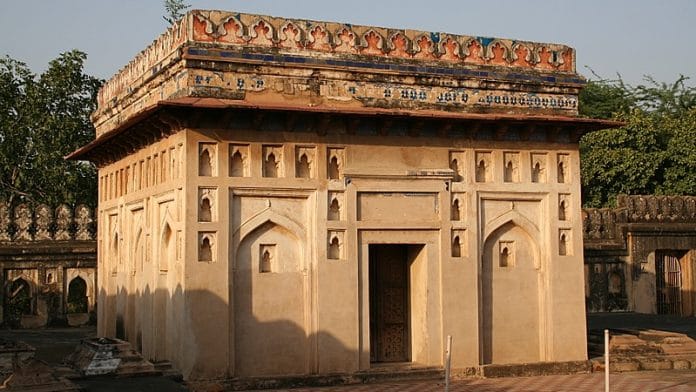Many of Delhi’s Mughal ruins and ancient tombs are silent sentinels of queer love. Their crumbling walls tell stories of love nurtured and celebrated. Some like the relationship between poet Shaikh Fazlullah and Kamali are steeped in myth, while others, like the mystic Sarmad Kashani’s passion for a Hindu boy, reveal that love can outlive prejudice and hate. To this day, these tombs and monuments are safe spaces for the LGBTQ community, a testimony to queer affirmation.
Jamali Kamali tomb: ‘It feels like a jewel box’
The Jamali Kamali tomb, which is adjacent to the Jamali Kamali Mosque in Delhi’s Mehrauli, is a fantastic piece of structural design with its red sandstone and marble embellishments. For some, it is also a beautiful shrine for ‘two lovers’. Built in 1528, the tomb is considered one of the finest pieces of Mughal architecture in the country’s capital.
The story begins and ends with Shaikh Fazlullah, a poet and traveller popularly known by his alias Jamali. The identity of Kamali, his mythical male lover, remains disputed. It is largely believed that the tomb got its name as a rhyming slang.
“The legend of the two lovers started in the 20th century and has been disproved many times. But the important thing is how it became a symbol for the LGBT community as a gathering point,” Sam Dalrymple, author and co-founder of Project Dastaan, says to ThePrint.
Plastered around the tomb are Persian poetry inscriptions about love and separation, further intensifying the folklore. “Jamali Kamali continues to be a site of queer affirmation and veneration for millions to this day,” Sam adds.
Also read: Pre-modern, pre-Section 377 Queer Ramayana shows sages desiring Rama’s body
Hijron ka Khanqah: ‘An oasis of solitude’
A ‘khanqah’ is a religious site that serves as a gathering place for Muslims of the Sufi discipline to experience a sense of calmness and moral clarity. This particular khanqah in Mehrauli used to be a Sufi spiritual retreat for eunuchs or the Hijra community. Dated to the 15th century, this monument is known for being a sort of burial ground for Hijras during the Lodi dynasty. With 49 tombs all over the place, a small terrace adjoining the tombs, and an air that is affectionately serene, the site continues to a place offering a sense of tranquility and peace.
Males who are castrated (eunuchs or hijras), and today recognised as part of the Third Gender, have been pushed to the fringes of society. But there was a time when they were revered for the special ceremonies they performed.
They were known for guarding harems and offering services to rulers and noblemen. “The reason why eunuchs were preferred for the other services was that they were no threat to the women of the harem, and since they had no chance of marriage or having children it was presumed they would have less reason to be corrupt,” writes author and historian Rana Safvi in her blog. Unlike how they are persecuted today, eunuchs had a distinguishable place in society in the Mughal era.
An ‘oasis of solitude’, as Rana Safvi calls it, the Hijron ki Khanqah in Mehrauli is only opened on request. The doorway seems to bend its back and loom over you and is made small so that “everyone enters the khanqaah with a bowed head”.
The Hijras of Turkman Gate own this place today, but the story goes like this. “It is said that Sufi saint Hazrat Qutubuddin Bakhtiyar Kaki had made one of the eunuchs in his times his sister. He fondly called her Aapa. This place was given to them by the saint,” Safvi writes.
Also read: ‘Why is your dad wearing a sari?’ South Indian films handle queer with care, unlike Bollywood
Tomb of Sarmad: ‘Shrine painted by a fiery shade of red’
Love across religions, the famous Aurangzeb and a beheading — the story of Sarmad Kashani allows us to traverse all three. Kashani was an Armenian Sufi saint and a lesser celebrated mystic who traveled to present-day Pakistan. Soon after, he fell in love with a Hindu boy, Abhay Chand.
“Sarmad often wrote a lot of poetry around homosexuality and used to wander naked,” says Shah Umair, a heritage enthusiast, numismatist and founder of creative agency Noon Social. Aurangzeb steps into the scene only when Sarmad becomes the spiritual guru and mentor of Dara Shikoh, Aurangzeb’s elder brother. In order to become the king, Aurangzeb not only executed Dara Shikoh but wanted to make sure Sarmad didn’t live either.
Sarmad’s grave now lies between Jama Masjid and Meena Bazaar. “He was beheaded on the steps of Jama Masjid, being accused of blasphemy. Ever since, his tomb has been celebrated by the homosexuals in Sarmad’s memory for he was the earliest spiritual master who was very open about his love for Abhay Chand,” adds Shah Umair.
From stories of affection towards a sister to love between two men that was forlorn to the celebration of a mystic — ‘the naked fakir’ — each of these heritage sites rings with bells of pride. The capital, New Delhi, well-known for its culture and history, must also be noted for its vast cultural reach into the realm of gender identities and sexualities.
(Edited by Prashant)






